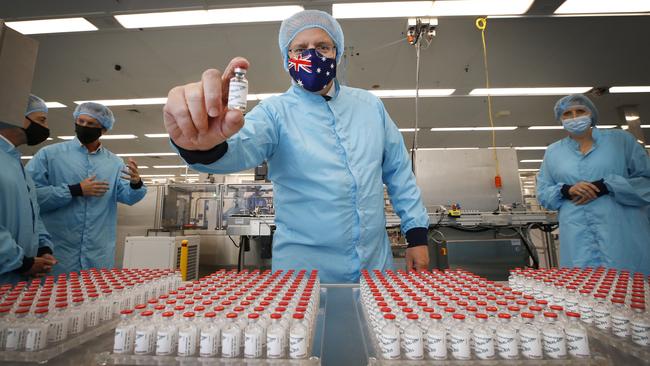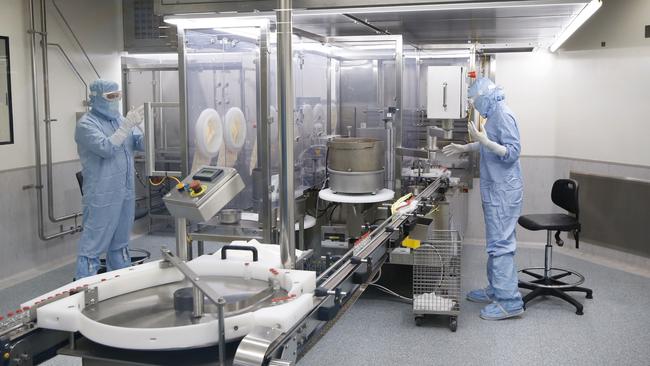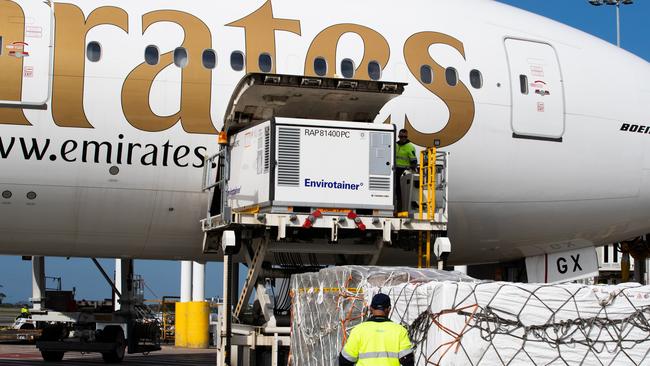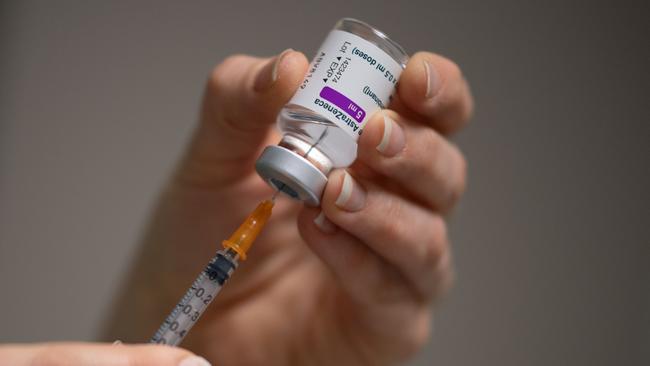Where the bloody hell are the vaccines?
Australia’s bungled vaccine rollout is a failure of panicked institutions and defective political culture that has seen the Morrison government indulge its worst habits.

The Morrison government has indulged its worst habits and its health bureaucracy, fiscally endowed but not operationally adroit, has been pushed past its capability. Pen-pushing Canberra, which doesn’t run a single hospital but waves a blank cheque, asserts itself on a shifting, tricky pandemic frontline.
Why? If you’re forking out $4bn on vaccines, the federal bill now after a visit to the late-night pharmacy to order another 20 million Pfizer jabs, you’ll want to hog the COVID-19 inoculation credit with voters. Yet, while the coronavirus wolf scratches at the door, an ugly reckoning has been kept at bay because of community sacrifice, a debt monolith, dumb luck and splendid isolation.
“You’d rather be in Australia than in any other country.” How many times have we heard that refrain from Scott Morrison, Josh Frydenberg and Health Minister Greg Hunt, and down through the government’s ministerial ranks? How often have Coalition pollsters told them that’s the vibe of the suburbs. If you don’t like it, go to Brazil.
But that is no longer washing with a jittery public, which is switching on to the reality of sweet promises about being at the “front of the queue” disintegrating into a litany of excuses: “goddamn Europeans”, interminable batch testing, the lazy states, blood clots.
We don’t have adequate supply right now because of decisions not taken last year and woeful contingency planning for what should have been obvious or plausible. It’s that simple.
The Prime Minister knows this; he’ll recall the desperation of personally trying last winter to secure something, anything, from big pharma as other nations locked in deals and our officials were erring on the side of watching and waiting. Sure, you want your national leader fighting for you. But Morrison dropped the ball and, like a league prop, he’s trying to make every tackle in the next set of six to compensate.

Remember, late last year Morrison amended the narrative from Australia being among the first to be vaccinated to having a “front-row seat” as nations such as the US and Britain, multitudes gasping and dying in the bleak midwinter, rolled out emergency-approved vaccines. Safe and steady wins a marathon race we were told as we settled into our beach chairs.
But the public mood flipped across the summer: where the bloody hell are the vaccines? A government commanding the podium was experiencing a “please explain” backlash. Harsh words and size-12 RMs got the bureaucracy off its holiday backsides in January to ramp up the rollout. But the vaccines, strategy and delivery infrastructure were not in place. Morrison found himself trying to talk his way through a wall of immovable facts. The Therapeutic Goods Administration was sticking to its mandate and the government’s mantra of safety first. Local vaccine production by CSL was never going to be ready until late March. The overseas-produced batches of the Oxford-AstraZeneca vaccine were severely limited.
Still, the government insisted “nothing to see here”, Australia was on track for four million jabs by the end of March.
Former federal Health Department secretary Stephen Duckett says our vaccine rollout has been over-promised and underdelivered. “The Morrison government made a number of mistakes, overhyping the vaccine as the key to reopening the economy and setting unattainable targets,” the Grattan Institute’s health and aged-care program director tells Inquirer.
Duckett argues the four million vaccinations by the end of March were never going to be achievable because of the “entirely foreseeable risk of vaccine nationalism”.
After the AstraZeneca vaccine didn’t arrive from overseas, the delivery target was reduced to two million, but we inoculated only one-third of that by the end of last month.

“We failed to achieve even the lower target because of local supply chain and distribution issues,” says Duckett, who sees the Health Department’s delivery inexperience as a crucial flaw. “The department’s lack of operational, on-the-ground capability meant that the government limited its options of how it could roll out the vaccine, which is through GPs. It could not do mass vaccinations, that’s the territory of the states. Once the government said the rollout was a commonwealth issue, with minimal state involvement, missing targets was inevitable.”
One of the galling aspects of the messaging rollback is the self-congratulation in the face of the exposure of systemic weaknesses. The idea the Morrison government has been an enlightened, brave champion of sovereignty, flaying the forces of free marketeers, is revisionist tosh.
“So the decision that our government took, the federal government took, to ensure that we had a domestically manufactured vaccine meant that we have a vaccination program,” Morrison said last week. “If we hadn’t taken that decision last August, then we would not have a vaccination program today. We wouldn’t be talking about the rate of vaccination, we’d be talking about no vaccination, and that was because of the foresight and the wisdom of the decision that we took in the midst of the crisis of the second wave of the virus in Victoria.”
He’s right in a way. We wouldn’t be talking about the rate of vaccination, we’d be lining up at Bunnings to buy pitchforks. Selling the avoidance of a greater debacle as foresight and wisdom and calling for applause for catching a lucky break is audacious and sad. The truth is it was CSL that came out of the murk of the early pandemic and put its hand up to help.
“We approached the government in February last year to offer any assistance that we could in the way that best made sense in terms of the local response to the pandemic,” Beverley Menner, who runs CSL’s COVID vaccine projects, told a Senate committee last month.
And how did CSL choose which vaccine to produce? “We were approached by AstraZeneca around the middle of the year last year and were asked whether we would have the capacity and the capability to step up and provide the AstraZeneca vaccine for Australia,” Menner said.
“That kicked off multiple discussions with both AstraZeneca and the government to get us to a place where we reached agreement with both of those parties to do that. So, it was an approach to us from AstraZeneca.”
Ultimately, the government agreed to bankroll the modifications to CSL’s plants to be able to produce the vaccine in Melbourne. CSL has a manufacturing contract with AstraZeneca; the global pharmaceutical company has a supply contract with the commonwealth, for 3.8 million doses from overseas, 50 million made locally.
Let’s wind back the clock to see how woeful Canberra has been, albeit in an environment of unproven vaccines, economic dislocation and mental fatigue. In a submission to Hunt last June, Health Department officials said: “Once a safe and effective vaccine or vaccines are developed there will be global competition from high and middle-income countries to ensure early access for their populations. Already countries, both as individuals and groups, are entering into advance purchasing agreements with vaccine manufacturers to ensure allocation.”
The US, Canada and European and Asian countries were locking in supplies as clinical testing of candidates progressed. “The mainstream media continues to report on vaccine development and public expectations of early access to any vaccine will be high,” the ministerial submission said.
Yet as Victoria’s second wave washed over Melbourne, putting it in stage-four lockdown, and more countries announced vaccine pre-purchases in July, it was clear Australia was leaving it late to lock in a deal. Industry sources detected anxiety among officials and ministers amid growing public disquiet.
On August 16, new Health Department secretary Brendan Murphy convened the first meeting of a crack 13-member advisory body, which included then acting chief medical officer Paul Kelly, chief scientist Alan Finkel and Australian Technical Advisory Group on Immunisation co-chairmen Chris Blyth and Allen Cheng.
The COVID-19 Vaccines and Treatments for Australia — Science and Industry Technical Advisory Group decided to recommend immediately that the government sign a letter of intent with AstraZeneca.
According to another brief to Hunt, the expert group noted while there were still questions over AZD1222 as clinical trials progressed, including in relation to eventual effectiveness and storage requirements, “this was the leading candidate and it was timely to make an investment”.
Three days later, Morrison summoned the cameras to AstraZeneca’s Sydney facility to announce the government had signed up with the British-based company. Even though Morrison called it a deal and an agreement, it wasn’t a legally binding instrument — merely the first step in a long process.
“Australians will be among the first in the world to receive a COVID-19 vaccine,” Morrison said. “The Oxford vaccine is one of the most advanced and promising in world, and under this deal we have secured early access for every Australian. If this vaccine proves successful we will manufacture and supply vaccines straight away under our own steam and make it free for 25 million Australians.”
This was big news for a nation that had been monitoring developments overseas, as well as for AstraZeneca. “The next steps, of course, are getting down into the details of contractual agreements,” the company’s local president, Liz Chatwin, said at the event. “The numbers, the timelines, the doses, the pricing and securing an agreement with our selected Australian manufacturers so we can manufacture the vaccine here locally should it prove successful.”
Morrison was able to secure 3.8 million offshore doses. An odd number, to be sure, one that would be unlikely to upset the distribution of vaccines to nations that had done deals for the Oxford candidate. At the time, the company had committed 1.1 billion doses to Europe, Britain, the US and the COVAX global facility. Australia eventually would ink supply deals in September and November, but we would pay a premium, around $350m more for the initial $1.5bn in deals with Pfizer and Novavax.
So what if we were paying more than other countries? With a budget deficit bulging towards $200bn, the Treasurer was stuffing $100 notes into anything with a pocket and a pulse. When the “molecular clamp” University of Queensland-Seqirus candidate was abandoned in December, the three other vaccine supply deals were scaled up.
Yet the chorus “Australia is at the front of the queue” was as persistent as it was pernicious. That baseless claim was simply overcompensating for the fact Morrison was slow to back a horse in the vaccine stakes.

On the surface there was skiting about vaccine supply, but beneath it there was hyper-secrecy about the details. Most aspects of our vaccine program — contract prices, indemnities, prioritisation and distribution — were not open to scrutiny. Even our elected representatives weren’t able to penetrate this protective custody, through parliamentary interrogation of officials or Freedom of Information processes.
One common criticism from former federal officials is that rather than working with the states on vaccine strategy and delivery, Canberra farmed out the brain work to big consulting firms. And what did they produce? Who knows?
Morrison’s default setting has been “trust us, we’ve got this, our experts are guiding us through”.
But those with an intimate knowledge of what was happening behind the scenes — medical experts, doctors, industry sources and state health officials — knew the federal government was over-promising.
The communications, always fundamental to the success of the rollout, was compromised before it entered the febrile world of partisan politics, federal-state blame games and a shift in public expectations. Morrison’s promise putting more “facts” into the narrative is welcome and essential but it does not scrub out the preceding grandiosity and the bendable talking points.
In The Conversation last week, Grattan’s Duckett detailed four key mistakes, saying leaders chose political grandstanding over good policy. First, the rollout pace is wrong. Second, the priority should have been hotel quarantine workers, then healthcare workers and then aged-care residents. Third, a slow boutique strategy relying on GPs could never meet the ambitious initial targets set. Fourth, the relentless political messaging makes it harder for the government to admit its mistakes, learn from them and reset the rollout.
“The government should publish a realistic vaccine rollout plan, to which it is prepared to be held to account,” Duckett wrote on the institute’s blog this week. “It should publish progress against that plan — including doses produced, doses acquired and people vaccinated. And it should publish that information each week. It is time for the federal government to level with Australians, so we can better understand what the plan is and whether everything really is going to plan.”
As micromanager of communications, the onus is on the Prime Minister.
The advice to Morrison on Thursday night from ATAGI on the AstraZeneca vaccine concerns it could cause rare cases of blood clots is not another stuff-up per se. It’s how nimbly you respond to such challenges, the rolling plans B, C, D and E you’ve put in place, that get you through. Do we have them? The government’s key advisers say yes we do. We should see a new timetable in coming days.
Morrison said a major recalibration would be required to the vaccination program for under-50s, with the government forced to rely on Pfizer vaccine or the yet-to-be-approved Novavax to complete the program. This would push out the vaccination timeline, perhaps into the early months of next year.
ATAGI advised that the locally made vaccine was safe for those over 50, and said those in priority groups aged under 50 who had already been given one AstraZeneca shot could safely receive the second jab. Morrison said his mother soon would be getting the Aussie-made product from her doctor.
Morrison vowed to release more information on the rollout and share data with the states. In his press conference after national cabinet on Friday, he presented a graphic showing total vaccination doses had broken through the one million mark. More than 81,000 people had received a jab in the past 24 hours alone.
Health chief Murphy accentuated the positive. The “most exciting recent development in weeks” was the take-up rate of the AstraZeneca vaccine among the 1B group: 47,000 people, mainly in their 70s and 80s, had received a jab from a GP in the past day. “Our program is going well and ramping up, along with many similar countries,” Murphy said.
Hunt outlined a possible path for a ramping up of Pfizer supply this month and next before a doubling in doses in July. He added the first doses of the fresh order of the only mRNA vaccine in our pharmaceutical cabinet would be arriving in October. It is possible that with an extra 20 million doses of Pfizer in the syringe-line more young people will be vaccinated earlier, given that the interval between shots is three weeks, compared with 12 weeks for AstraZeneca.
A reporter asked whether all adult Australians would have at least one dose by Christmas. Morrison said he wasn’t in a position to be able to confirm that.
Australia has been blessed by its geography, citizens obedient to a fault, and fortunate to have the deep pockets to buy itself out of mistakes made before the crisis, such as planning around personal protective equipment and procurement protocols in an emergency, and during it, like a reluctant buy-up at the vaccines candidate shop.
We were slow out of the blocks on every aspect of vaccines policy and strategy. Officials and ministers were convinced there was no hurry because we flattened the curve of coronavirus cases, prepared our intensive care units in hospitals, and developed competent testing and tracing capability.
An “abundance of caution” may have been the catch cry for social distancing and trading restrictions, but it was the default for our timid officials, at odds with the billion-dollar talk of Morrison and Hunt.
Recalibration, the new motto, is not a defeat, but it should serve as a wake-up call for the Prime Minister.
Playing policy catch-up is not pretty in real time. Trust has been forfeited, with the states, the medical profession, aged-care providers and the public now slightly alarmed. Morrison has another chance to reset, but people are looking at him and listening to his overtures differently. He no longer commands the rules of the game.


Australia’s bungled vaccine rollout is a failure of panicked institutions and defective political culture. It may have manifested itself to many only in the past few weeks, but the flop is a product of collective complacency, at times hubris, and deterioration in transparency and accountability to the public.